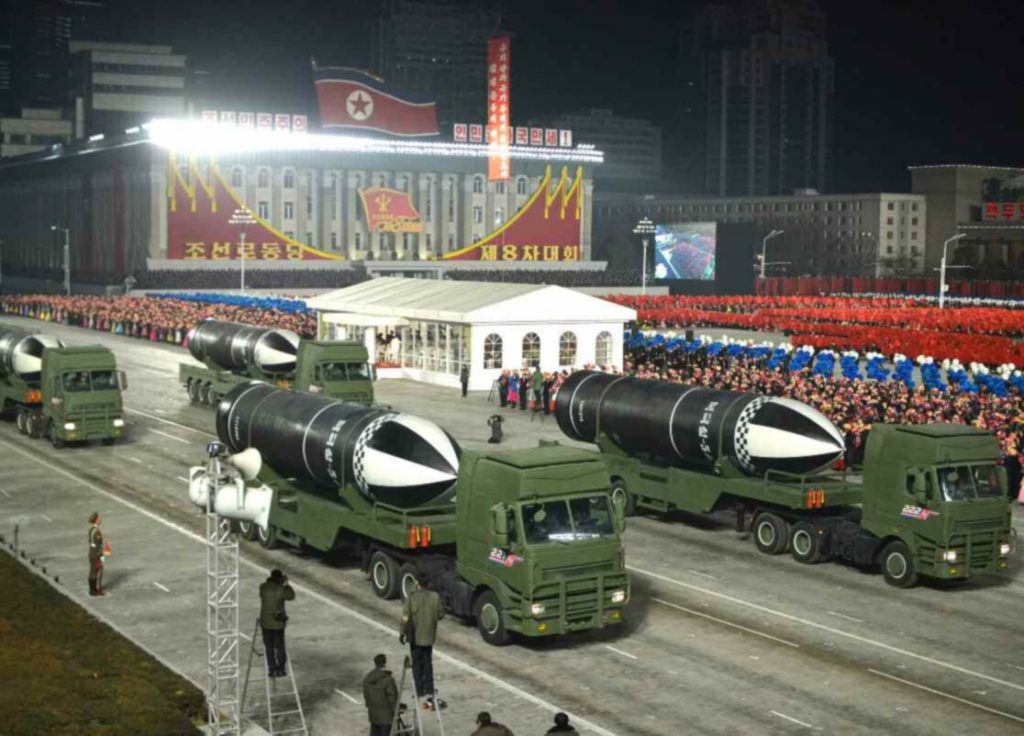North Korea Plans to Further Develop its Nuclear Strike Capabilities Despite Economic Constraints
At the recent Eighth Party Congress of the Workers’ Party of Korea (WPK), North Korean leadership announced plans and programs to expand its nuclear deterrent—specifically, the development of miniaturized nuclear warheads, tactical nuclear weapons, multiple independently-targetable reentry vehicles (MIRVs), solid-fuel ballistic missiles of varying ranges, nuclear propulsion systems for submarines, and hypersonic boost-glide vehicles. There are already indications at Yongbyon and defense-related institutes that activity in support of these plans is underway.
This is an ambitious program for a small country, which is suffering from economic mismanagement, severe United Nations (UN) sanctions, and the effects of the pandemic and natural disasters. Some of these projects have been under development in recent years, but it will take more than a decade to field advanced systems such as MIRVs fitted with nuclear weapons, nuclear submarines with missiles and hypersonic glide weapons.[1] Furthermore, all this will require boosting production of fissile material—plutonium and enriched uranium—and testing of nuclear warheads, which would violate the provisions of UN Security Council resolutions.
To meet the near-term requirements for the production of plutonium and uranium, North Korea would need to construct an additional nuclear reactor to produce plutonium; expand its current spent fuel reprocessing and uranium enrichment capabilities; increase uranium mining, milling, conversion, and nuclear fuel fabrication both for the 5 MWe reactor and the Experimental Light Water Reactor (ELWR) at Yongbyon; and possibly establish another nuclear test site to conduct higher-yield nuclear weapon tests.[2] Ideally, new infrastructure would need to be built to implement the North’s stated nuclear plans. However, given its economic constraints, the North will instead likely take as much advantage as possible of the existing nuclear infrastructure in Yongbyon—activities which would be visible in satellite imagery.
In his closing speech, Kim Jong Un also indicated that the North may have failed in munition production. Public reports of the Party Congress did not provide details on these failures, but it may suggest that North Korea did not achieve all its targets in developing the nuclear deterrent. One indication of this is the slow commissioning of the ELWR in Yongbyon, which is well behind the target operating dates disclosed in 2010. Whether these delays relate to the design and construction of the reactor, fuel fabrication, or requirements for uranium enrichment remains unknown. It could also be the case that the enriched uranium needs of the nuclear weapons program were given a higher priority than those of the ELWR.
Kim also emphasized in his speeches further building the national defense capacity in quality and quantity, which includes strengthening “the nuclear war deterrent.” An important part of these efforts is defense-related research and development programs highlighted in the reports of the Congress.
Kim’s statements will certainly raise concerns, particularly in the US, China, South Korea and Japan. Miniaturization of nuclear warheads is essential in building tactical nuclear warheads for shorter-range missiles threatening the ROK, Japan and US forces based in the area.
Over the longer-term, the strengthening of the North’s nuclear deterrent will also boost South Korea’s aspirations to acquire submarines with nuclear propulsion in response to North Korean threats and Japanese ambitions to go ahead with its plans to develop, inter alia, hypersonic glide missiles with conventional warheads to counter current and future North Korean (and Chinese) missile capabilities.
North Korea’s nuclear plans, while they may be constrained by limited resources, are likely aimed at establishing a fait accompli in advance of possible denuclearization talks with the Biden administration and increasing the North’s leverage in these negotiations. The debate in Pyongyang over its nuclear program will continue on Sunday, January 19, with the meeting of the Supreme People’s Assembly, which traditionally blesses the decisions of the WPK Congress.
The new DPRK five-year economic plan should help to inform the new Biden administration’s review of North Korea policy. Although the continued growth of the North’s nuclear capabilities is a major concern, the slower-than-anticipated progress of their nuclear programs suggests there may be time to conduct a comprehensive review and to engage with regional parties on developing a common approach to the North Korean nuclear problem.
Figure 1. A new submarine-launched ballistic missile (SLBM), Pukguksong-5, which is under development and yet to be tested, was presented on January 14 in a military parade.

- [1]
Hypersonic glide vehicles (HGVs) are delivered atop of a medium- or long-range missile. They do not follow a ballistic missile trajectory, but their ability to maneuver after they have been released from their rocket boosters makes it difficult to detect, trace and shoot them down. Russia and China have developed and deployed such weapons. The US hypersonic glide vehicle is in development. Brazil, India and Japan are known to develop such missiles. Read more in: Kelly M. Sayler and Amy F. Woolf, Defense Primer: Hypersonic Boost-Glide Weapons, CRS IF11459 (Washington, DC, Congressional Research Service, December 1, 2020), https://fas.org/sgp/crs/natsec/IF11459.pdf.
- [2]
There are concerns that the Punggye-ri site in particular has deteriorated as a result of the high-yield test in September 2017.
